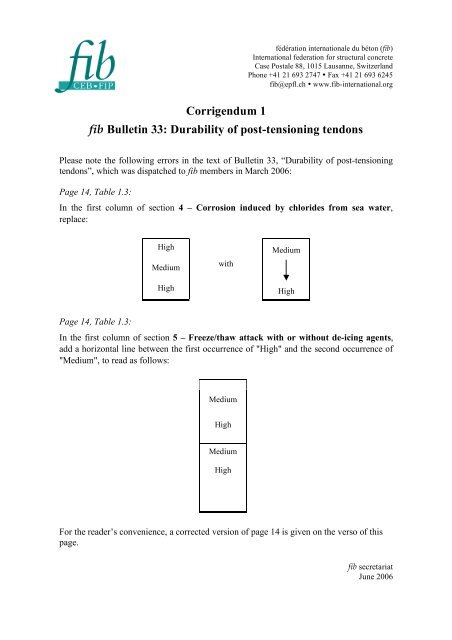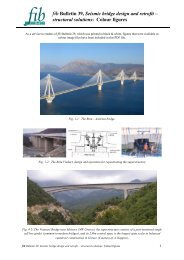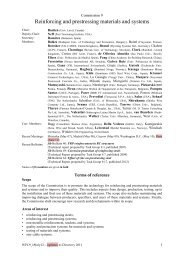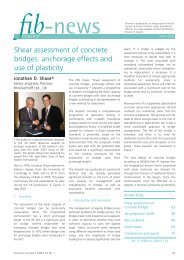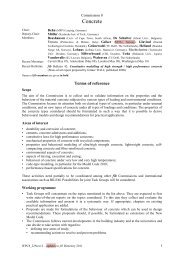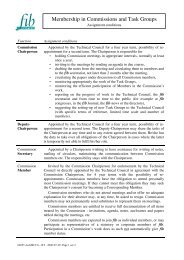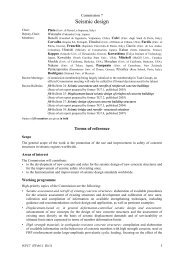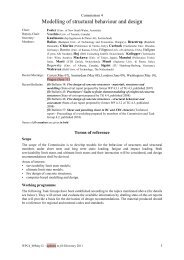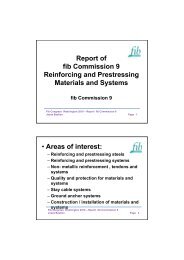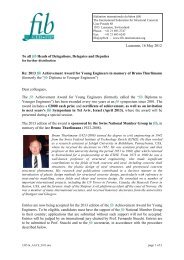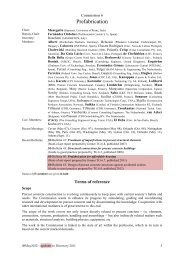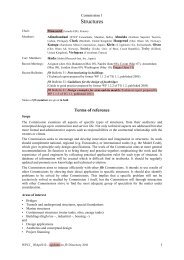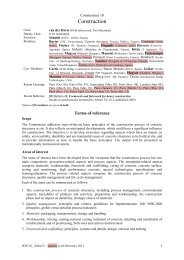Corrigendum 1 - The International Federation for Structural Concrete
Corrigendum 1 - The International Federation for Structural Concrete
Corrigendum 1 - The International Federation for Structural Concrete
You also want an ePaper? Increase the reach of your titles
YUMPU automatically turns print PDFs into web optimized ePapers that Google loves.
<strong>Corrigendum</strong> 1<br />
fédération internationale du béton (fib)<br />
<strong>International</strong> federation <strong>for</strong> structural concrete<br />
Case Postale 88, 1015 Lausanne, Switzerland<br />
Phone +41 21 693 2747 • Fax +41 21 693 6245<br />
fib@epfl.ch • www.fib-international.org<br />
fib Bulletin 33: Durability of post-tensioning tendons<br />
Please note the following errors in the text of Bulletin 33, “Durability of post-tensioning<br />
tendons”, which was dispatched to fib members in March 2006:<br />
Page 14, Table 1.3:<br />
In the first column of section 4 – Corrosion induced by chlorides from sea water,<br />
replace:<br />
Page 14, Table 1.3:<br />
High<br />
Medium<br />
High<br />
with<br />
Medium<br />
In the first column of section 5 – Freeze/thaw attack with or without de-icing agents,<br />
add a horizontal line between the first occurrence of "High" and the second occurrence of<br />
"Medium", to read as follows:<br />
Medium<br />
High<br />
Medium<br />
High<br />
High<br />
For the reader’s convenience, a corrected version of page 14 is given on the verso of this<br />
page.<br />
fib secretariat<br />
June 2006
Aggressivity<br />
levels<br />
Class<br />
designation<br />
Description of the environment In<strong>for</strong>mative examples where exposure<br />
classes may occur<br />
3 – Corrosion induced by chlorides other than from sea water<br />
Medium XD1 Moderate humidity <strong>Concrete</strong> surfaces exposed to airborne<br />
chlorides<br />
XD2 Wet, rarely dry Swimming pools<br />
<strong>Concrete</strong> exposed to industrial waters<br />
containing chlorides<br />
High XD3 Cyclic wet and dry Parts of bridges exposed to spray<br />
containing chlorides<br />
Pavements<br />
Car park slabs<br />
4 – Corrosion induced by chlorides from sea water<br />
Medium XS1 Exposed to airborne salt but not in direct<br />
contact with sea water<br />
Structures near to or on the coast<br />
XS2 Permanently submerged Parts of marine structures<br />
High XS3 Tidal, splash and spray zones Parts of marine structures<br />
5 – Freeze/thaw attack with or without de-icing agents<br />
Medium XF1 Moderate water saturation without deicing<br />
agent<br />
High XF2 Moderate water saturation with de-icing<br />
agent<br />
Medium XF3 High water saturation without de-icing<br />
agent<br />
High XF4 High water saturation with de-icing agent<br />
or sea water<br />
6 – Chemical attack<br />
Medium XA1 Slightly aggressive chemical environment<br />
according to table 2 (of EN 206-1)<br />
XA2 Moderately aggressive chemical<br />
environment according to table 2<br />
(of EN 206-1)<br />
High XA3 Highly aggressive chemical environment<br />
according to table 2 (of EN 206-1)<br />
Vertical concrete surfaces exposed to rain<br />
and freezing<br />
Vertical concrete surfaces of road<br />
structures exposed to freezing and<br />
airborne de-icing agents<br />
Horizontal concrete surfaces exposed to<br />
rain and freezing<br />
Road and bridge decks exposed to deicing<br />
agents<br />
<strong>Concrete</strong> surfaces exposed to direct spray<br />
containing de-icing agents and freezing<br />
Splash zones of marine structures exposed<br />
to freezing<br />
Table 1.3: Aggressivity level and exposure examples as entry points in Table 1.2 (after EN 206-1)<br />
1.4.4 Considerations <strong>for</strong> selecting the protection layers provided by the structure<br />
For applying the principle of multi-layer protection (see section 1.3.1), reference should be made to<br />
the following sections:<br />
- section 1.3.3 <strong>Concrete</strong> quality and cover;<br />
- section 1.3.4 Waterproofing systems and other surface protection systems;<br />
- section 1.3.5 Drainage system;<br />
- section 1.3.6 Expansion joints;<br />
- section 1.3.7 Cracking;<br />
14 1 Design concepts <strong>for</strong> durable post-tensioning tendons


